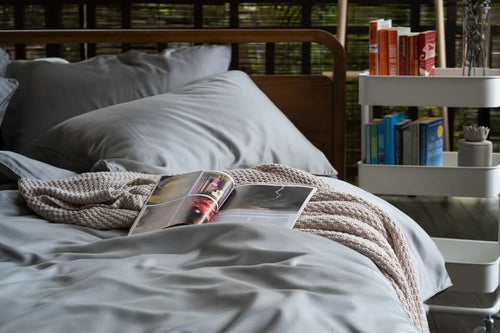It’s a no-brainer that a good night’s sleep is vital for optimal health. The fact that people on average sleep for approximately one-third of their life already makes it a big part of everyone’s existence.
With that said, improving your sleep quality is no less than essential. One way to do this is to make your bed the most comfortable place in your home with quality bedding, such as a comforter blanket, quilt, or duvet.

Image by Alex Green from Pexels
Just like in choosing the right bed sheets, buying the best duvet can be daunting given the plethora of options - from the more common down material to other natural and synthetic-filled duvets. In this article, we’ll compare down vs. down alternative pros and cons to guide you in picking the best option for you.
What Is A Duvet?

Image by Miriam Alonso from Pexels
A duvet, derived from the French word that means “down, is a type of top layer of bedding that originated in Europe. While it can serve as a bed decoration, it is mostly used for heat and insulation during sleep.
This type of blanket is made using baffle box stitch or construction. It involves inserting thin strips of fabric and sewing them in pockets or stitched squares, usually called “baffle boxes”, to keep the filling in place.
What Are Duvet Inserts?

Image by cottonbro from Pexels
Another term for duvets, duvet inserts are an optional bedding layer commonly paired with a duvet cover in Singapore. The filled blanket that tucks within the cover is referred to as the "insert" whereas the fabric that encases it is the cover.
Well-designed inserts usually have loops that attach to their corner ties to steer clear of slipping. They come in various warmth levels to suit different sleeping preferences. Also, their filling determines whether they are a down or a down alternative.

Featuring Weavve’s TENCEL™ Lyocell Duvet with Corner Loop Ties
What Are Down Duvet Inserts?
Traditionally, down is used to fill duvets. It is a filling gathered from underneath the outer covering of feathers of geese, ducks, and swans.

Image by Artem Podrez from Pexels
|
Pros |
Cons |
|
|
Are Down Duvets Worth It?

Image by Rūdolfs Klintsons from Pexels
Down is often the go-to option when it comes to fillings. However, it does not always guarantee the best and most gentle material. Try expanding your options to alternative duvets and you’ll likely find the one that fits your preferences and budget.
Discovering Down Alternative Bedding

Featuring Weavve’s TENCEL™ Lyocell Duvet
A down alternative insert is an innovative material usually made from either another form of natural or semisynthetic filling like TENCEL™. Others may be filled with synthetic stuffing, such as polyester microfibre fill. It is also used in stuffed animals and pillows. Moreover, it comes in different shapes and sizes to simulate the feeling of an authentic down duvet.
4 Best Down Alternative Duvet Inserts
If you decide that down is not for you, go for down alternatives. They are commonly made using these materials:
Wool

Image by Lukas from Pexels
This material is made from the hair of different types of animals. The fur is spun or made into yarn, then woven into an insert.
|
Pros |
Cons |
|
|
Bamboo

Image by Pixabay from Pexels
This material is made of bamboo fibres. Since these fibres run end-to-end, they can last for many years.
|
Pros |
Cons |
|
|
Silk

Image by Davis Vidal from Pexels
Silk is a protein fibre harvested from silkworms. It is ideal for hot sleepers who enjoy sleeping with a blanket that naturally drapes around their body while they sleep.
|
Pros |
Cons |
|
|
TENCEL™ Lyocell

Image by TENCEL™
TENCEL™ is one of the best duvet alternative materials. In particular, TENCEL™ Lyocell duvet quickly absorbs moisture and regulates temperature, offering a more comfortable deep sleep. It also has natural anti-bacterial and anti-odour properties that suit those with allergies.
This type of material offers similar comfort as down and even surpasses down when it comes to breathability. Thus, you can count on sleeping more peacefully without night sweats.
|
Pros |
Cons |
|
|
Down Vs Down Alternative Duvet Insert: A Comparison

Image by Craig Adderley from Pexels
Choosing between down and down alternatives can be confusing. Generally, the right option depends on your sleeping needs and preferences. Make sure to consider these factors before buying:
Comfort

Image by Eren Li from Pexels
The comfort of the duvet depends on the fill power, which measures the number of cubic inches an ounce of down or down alternative takes up. It affects the breathability, insulating ability, fluffiness, and loft. The higher the fill power, the lighter and warmer the blanket is.
Compared to down alternatives, down is fluffier and more insulating. A 500-750 fill power is ideal for most sleepers in terms of fluff and insulation. Plus, it is extremely light and breathable while offering adequate warmth.

Image by Castorly Stock from Pexels
Synthetic options have a unique composition, so their fill power can be challenging to determine. They need much more filling to reach the same insulation level as down. Because of this, they tend to be heavier. They might also trap body heat since they don’t regulate temperature well.
If you want a lightweight and breathable material, you won’t go wrong with natural fibres like TENCEL™ Lyocell or bamboo. They are naturally moisture-wicking and temperature-regulating, making them perfect for all seasons.

Featuring Weavve’s TENCEL™ Lyocell Duvet
Cost
The cost depends on the production process, particularly how the materials are sourced.
Down is sourced from wildfowl. Since animal feathers are a limited resource that requires more time and labour to acquire, expect them to be more expensive.

Featuring Weavve’s TENCEL™ Lyocell Duvet
An alternative to down is usually budget-friendly unless it is made of higher-quality natural fibres such as 100% TENCEL™️. Synthetic ones are cheaper to produce, making them a more affordable option.
Maintenance
Cleaning a duvet is simple. However, traditional down duvets usually require more work. On the other hand, down alternatives are easier to maintain.

Image by SHVETS production from Pexels
Washing a down comforter or quilt in Singapore can be more complicated, since it usually cannot be cleaned in a washing machine. Instead, it has to be dry-cleaned every 2–3 years. To minimise the need for washing and help it last longer, use a cover with your comforter.
On the other hand, some down items may be machine-washable. Utilise dryer balls if you decide to tumble-dry your blanket.

Featuring Weavve’s Wool Dryer Ball
This type of blanket is ideal for those who prefer a low-maintenance option. It is washer and dryer-safe. When washing with a machine, use cool water and mild laundry detergent.

Featuring Mundo Eco Laundry Detergent Sheets
Durability
If you prioritise investing in bedding that can last for years, choose between down and down alternative wisely.
Down is more durable than its synthetic counterparts. The material can last 10-15 years, depending on upkeep.

Image by Yan Krukov from Pexels
Down alternatives made of synthetic materials break down quickly. They tend to lose their shape sooner due to the composition of the fibre. Also, they are more prone to wear and tear since they are easier to wash at home. In short, although they are cheaper, they will need to be replaced more frequently.

Image by Cats Coming from Pexels
However, if you want a long-lasting material akin to down, comforters made of strong TENCEL™ Lyocell fibres make an excellent choice. They are incredibly durable and have a longer lifespan as well.
Down Or Down Alternative: The Verdict
Now that you know more about the differences between down and down alternative inserts, you probably have a better idea of which one to buy. One thing to keep in mind is choosing a duvet in Singapore points down to personal needs and preferences.

Featuring Weavve’s Singapore Duvet Made of TENCEL™ Lyocell
Who Should Choose A Down-Filled Duvet?
- Sleepers who prefer a fluffier, more pillow-like feel
- Sleepers who want to invest in a long-lasting sleeping material
Who Should Choose A Down Alternative?
- Sleepers who suffer from allergies
- People who prefer a less expensive option (especially for synthetic fillings)
- People who want a machine-washable comforter
- People who stay away from buying animal-based products
Looking for a down alternative to keep you cool and comfy all night? Explore Weavve Home's duvet in Singapore!




































